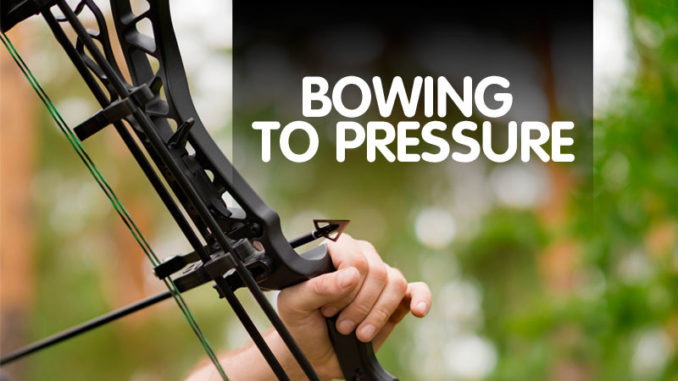
Preparation, perspiration and persistence are keys to successful early season archery hunts for whitetails.
Early season bow hunting can be one of the more challenging ways to hunt white-tail deer. But it can be perhaps the most rewarding of all to a serous bow hunter.While the mid-season problem of hunter pressure isn’t something to worry early season hunters, other factors must be considered and overcome to be successful.
Serious bow hunters leave little to chance or luck. Preparation is their key to success and usually is the difference between looking at a buck through a peep sight or wondering where all the whitetails that made a zillion tracks are hiding.
Mike Cox has long been a serious bow hunter and spends as much time planning for bow season as he does hunting.
“Every time I’m in the woods throughout the year, for whatever reason, I’m thinking bow hunting,” Cox said. “This is true even when I’m turkey hunting in the spring. I’ll hunt gobblers with gun or bow, but I’m always looking for a good tree to hang a bow climber for the fall deer season.
“As the summer progresses, I plant food plots, bush hog shooting lanes and just wander around the woods thinking bowhunting strategy. I’m always looking for scenarios where I’ll have an edge with a bow. That, I believe, is a real key to success.
“If I can just get a small advantage in terms of having the ideal setup, it often means the difference between seeing deer but not getting a good shot or having that ideal quartering shot to the vitals. Setup can be everything.”
Cox said early season bowhunting begins with practice with the bow and getting stands up early, well before the season begins.
“I know hunters hear it often, but practice, practice and practice some more before the season,” he said. “I know a lot of guys can put the bow up at the end of the deer season and pull it back out the next season the day before they hunt and group arrows dead on target.
“So can I. But what I don’t have if I don’t practice is a smooth, unconscious, natural rhythm to my shooting.
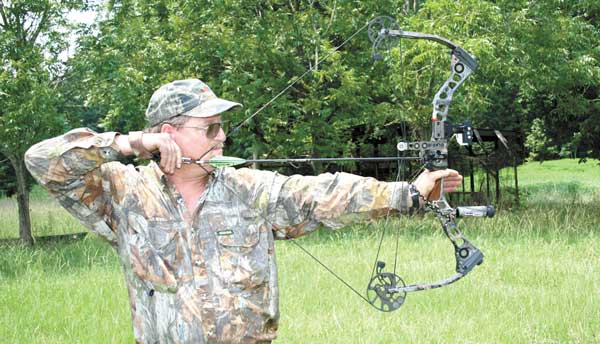
“With repetitive practice, my body is conditioned to hold steady at full draw longer, my technique is mentally ingrained and the only thing I have to focus on is the deer. Once the deer gets into sight, my focus is the moment when the killing shot is presented.
“Most of my kills are with shots that just happen. I focus on the single hair on the deer where the arrow needs to be. I don’t have to worry about proper form, a smooth release or follow through; I’ve practiced it until it’s natural. I have enough to worry about to just getting a killing shot on a nice buck.”
Another key factor is hunting where deer are located during the early season. It sounds simple, Cox said, but some hunters automatically go to areas where they kill deer during the rut. But often during early bow season, deer are elsewhere.
“Hunting the early bow season can be real productive,” Cox said. “It can also be unpredictable unless you do your homework.
“There’s a lot of preparation that goes into successful hunts anytime of the season. But despite what some hunters think, early season doesn’t necessarily mean whitetail deer will be easy targets.
“If you don’t know where the deer are bedding, feeding and the basic travel routes, you can be in for some long, hot, unproductive hours in the stand. But armed with a good game plan, you can enjoy great hunting and have an early season opportunity to take a big buck.”
Cox said other than the rut, perhaps the best time to take a trophy in will be during those first few days of the early season. One reason is simply deer, particularly big bucks, haven’t been pressured a lot.
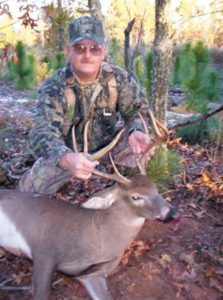
“It doesn’t take too long for big bucks to feel the pressure once the season opens,” Cox said. “That’s why you hear people talking a lot about seeing big bucks before the season as they drive along the road or sometimes while driving a 4-wheeler through their hunting club. But once hunters start sitting in stands that usually will change.
“Find the bedding, feeding and the travel routes between these two areas. Then, consider the prevailing wind for this time of the year. Often, early season bow hunting time will have totally different winds than during the rut or late season.
“I place bow stands at different areas planned for different parts of the season. I also select a lot of different trees and have them limbed and ready for climbers.
“In conjunction with planning, more than any other aspect, employing the use of a climbing bow stand is a key to my success. With a climber, I can adapt to deer movements and changing wind patterns. It’s crucial.”
Cox said getting permanent bow stands up early and in the right places in terms of wind direction are doubly good ideas. Even two to four weeks early isn’t too late to hang a stand. However, as a rule of thumb, he has his stands in place and left alone in terms of human scent for perhaps two months or more before the season opens.
“Through the years, I’ve found it crucial to determine my stand sites and get them where I want them long before the season opens,” Cox said. “Also I get them limbed up (removed obstructive limbs) for shooting and camouflaged as much as possible.
“I use some of the leafy camouflage at times to help hide the stand, but I try to make maximum use of the existing natural vegetation in the area.
“Use natural surroundings to blend into the woods as much as possible. The more successful a hunter is at doing that, the more deer he’ll see throughout the season; that’ll be because they don’t see or smell you.
“While I’ll cut lanes for open shots, I pick those lanes carefully. Don’t over-clear an area where you have too clear of vision. That makes you much more obvious to the deer as well.
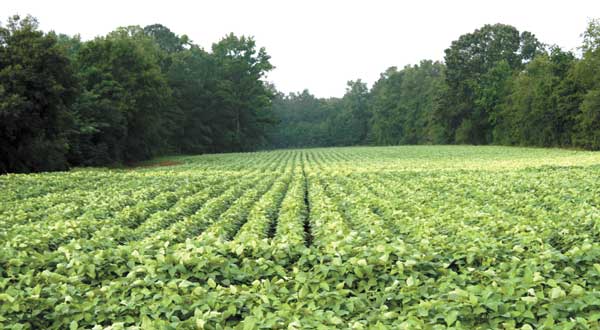
“Deer aren’t stupid regarding what’s normal for the woods. They know a deer stand is out of the norm for their woods. They’ll get used to the stand over time. Scent, movement and even small noises will contribute to a hunter not seeing deer.”
Cox said when a hunter determine food sources and bedding areas, the key to his stand location is getting between these two areas and hopefully catching deer moving from Point A to Point B. Look for areas of fairly dense vegetation that lead from bedding areas to food sources.
For example, Cox said once a deer reaches soybeans, a cornfield or other food source, they’ll likely move out of bow range quickly. If a hunter don’t get within shooting range of the main travel route, he may have to look at several deer for a long time knowing he’s not going to get a bow shot.
In this instance, Cox said hunters need to find the primary routes deer are taking to these food sources. Actually a hunter doesn’t need to have a stand within sight of a field, just along the route the deer typically take. After consideration of the obvious rules for bow hunters regarding wind direction and position of the sun (whether rising or setting) he’s ready to select a stand site.
Charles Robinson is another bow hunter who loves to use sticks and feathers to take early-season deer. Robinson uses several tactics to help him have successful hunts.
“Big bucks, even during early bow season, require hunters to get off the beaten path, so to speak,” Robinson said. “Once the bucks get pressured, they’re going to be much less likely to step out in the open during the daylight hours. To get a shot at a big buck a hunter may have to get back in the thickets and swamps with them.
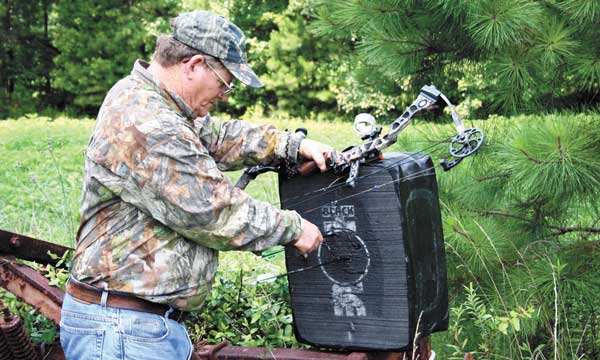
“That can also mean tight quarters. But this is actually a good setup for bow hunting. Some places bucks will be using this time of the year may not have much more than 20 or 40 yards of vision.
“A lot of the areas I hunt have corridors where I locate a narrow funnel that deer travel before dark on the way to a food source. This is an ideal situation to use climbing stands.
“Because of being so close to the deer, I also use scent-hiding clothes. It’s good throughout the season but crucial in the early season when it’s warm or sometimes downright hot.
“Place the stand so it’s hidden but affords some open lanes to shoot. Consider the prevailing wind to give you the wind advantage. Mosquito’s will be a problem in the heat and humidity, especially if hunting in or near swamps. I use ThermaCells in the early season. I also suggest discretion regarding hunting any area too frequently. A little bit of human intrusion can go a long way, sometimes the wrong way.”
“After I hunt a stand I’ll let it rest a couple of days before going back to it. I always have backup stand sites, so I’ll always hunt with the advantage of the wind. Wind consideration is always crucial, but when hunting deer in what is literally their living room, it’s best to simply not hunt rather than go to an area when the wind direction is wrong.”
Cox said knowing the local woods is critical in terms of knowing what food sources are hot.
“Different terrain and different parts of the state will dictate what food sources are attracting deer,” he said. “For example, one of my favorite early-season natural deer attractors is persimmon trees. Deer love them, and I have places where my climber puts me in the right position to take a nice buck. However, when the persimmons are gone, I’m wasting time to hunt that spot.
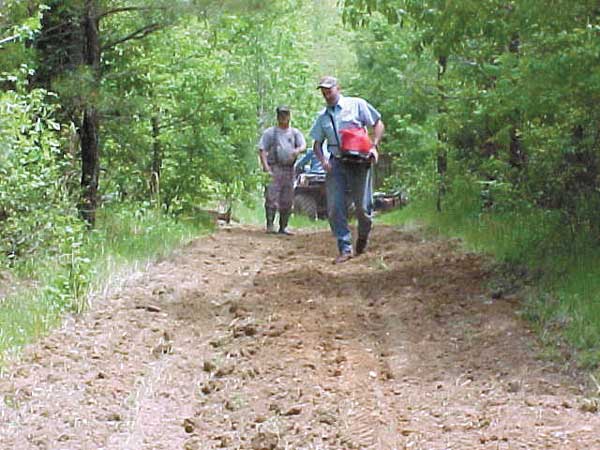
“Different types of oak trees produce mast at different times. I’ll know which ones are producing and when they start becoming a primary source of food for the deer in that area.
“The list of potential foods is long. But identify what’s in the woods where you hunt, track the use of it and plan hunts accordingly. Until the rut kicks in, food, water and cover are the issues you need to consider.”
Cox said food plots can be another deer magnet and are always a potential location for stand sites. Get the ground worked up and planted in pre-season and have food sources growing to attract deer, and the odds of success improve. Food plots will pay more dividends in late season when food sources get scarce, but they’re a plus during early season.
“One thing I do is spot-check for deer activity during the days immediately prior to the opening week of hunting,” Robinson said. “Not deep intrusion, just checking for recent sign of travel and use of different food sources.
“I quickly and quietly scout the areas I intend to hunt. A quick trek through during the mid-day when the deer are most likely bedded down away from the feeding areas is the best time. Look for ingress and egress routes deer are using to ensure stand locations are still in the right places.”
Robinson has other suggestions to consider for early season bowhunting success.
“During the early season, much of the deer movement will be in low-light conditions,” he said. “A lot of bucks move late and the type of (bow) sights a bowhunter uses can impact success. Compound bows with peep sights and pins can be difficult to see. I switched to fiber-optic pins and that has significantly improved my late-evening vision.
“Another early season tactic is to use deer calls. Some hunters won’t use calls early in the season. But using a simple bleat or grunt call can be effective.
“I don’t overdo it, I just make a subtle call every once in a while. It’ll get the attention of nearby deer and I’ve had them approach on many occasions. Of course, they’re looking for the source of the call as they approach and that means I’ve got to be still and have the wind to my advantage. But it’s a valuable early season tool that will get deer into bow range.”
Cox said preparation for early season bowhunting is an on-going event.
“It’s never too late to start and it’s never too early to begin,” Cox said.
“Whether a hunter has an opportunity to harvest a buck opening day or opening week is usually not a factor of luck; it’s how well prepared a hunter is for the season.
“For success early in the season, plan your hunt, hunt according to your plan and liberally apply patience.”




Be the first to comment